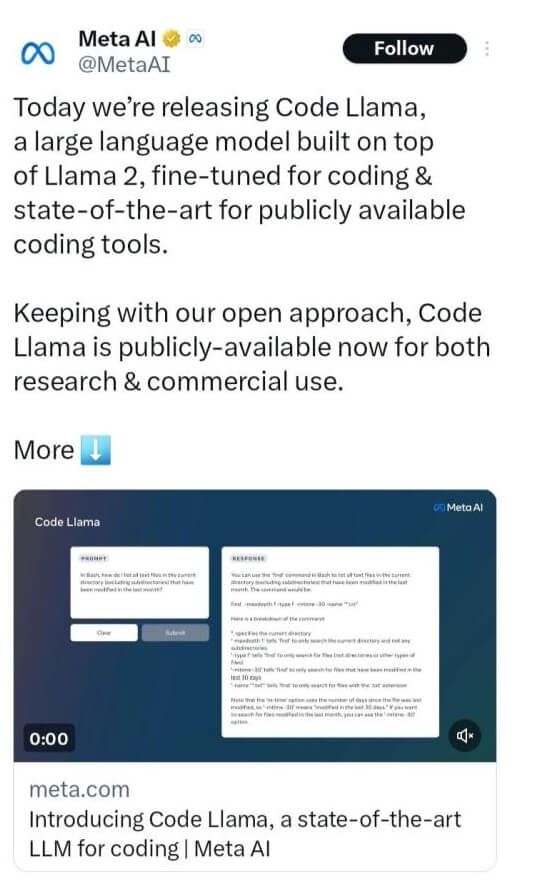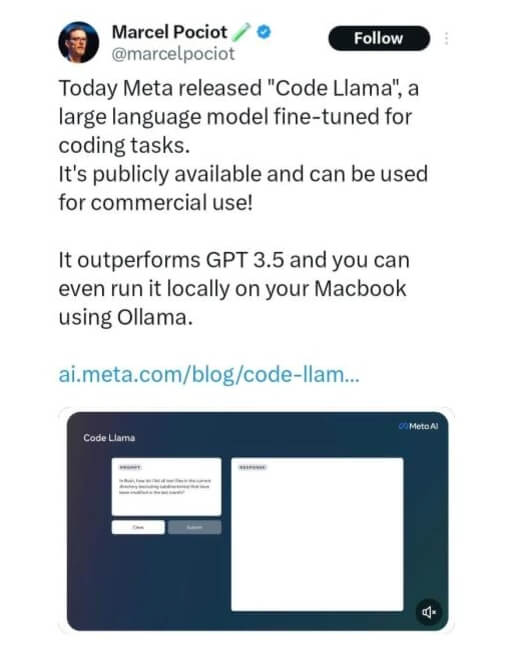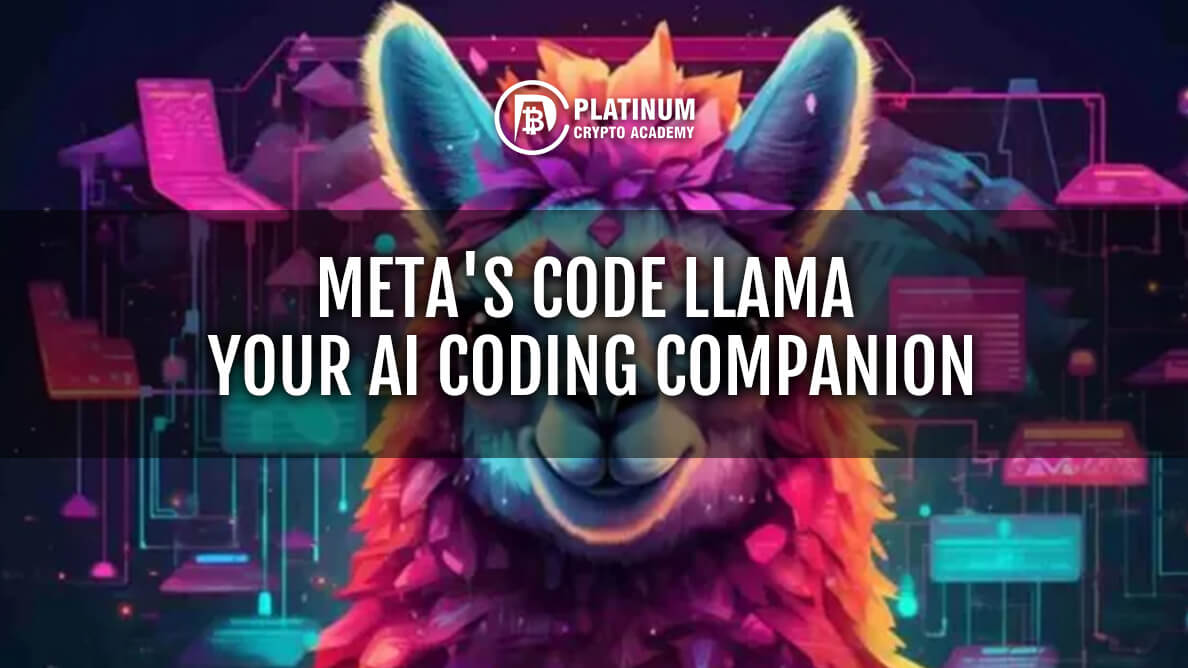Meta, formerly known as Facebook, has announced the launch of its innovative AI tool for code creation and debugging, Code Llama. This tool leverages Meta’s Llama 2 large language model to streamline workflows and enhance efficiency for both seasoned developers and coding novices. As we’ve discussed in a previous article on The Convergence of AI and Crypto, the integration of AI into various technological spheres is a topic of growing importance, and Code Llama is a prime example of this trend.
Code Llama: The AI Code Whisperer
Positioned as a free educational resource, Code Llama helps programmers craft robust, well-documented software. It can generate code and provide explanations in plain English based on code inputs and textual prompts, such as “create a function that generates the Fibonacci sequence.” https://www.youtube.com/watch?v=6PDk-_uhUt8
Moreover, it is available for commercial use without any associated fees. An announcement came from Meta’s official account stating, “Today we’re releasing Code Llama, a large language model built on top of Llama 2, fine-tuned for coding & state-of-the-art for publicly available coding tools. Keeping with our open approach, Code Llama is publicly available now for both research & commercial use.”

Marcel Pociot, the CTO at BeyondCode, says “Today Meta released “Code Llama”, a large language model fine-tuned for coding tasks. It’s publicly available and can be used for commercial use! It outperforms GPT 3.5 and you can even run it locally on your Macbook using Ollama.”

A noteworthy feature of Code Llama is its adaptability. It can either generate code segments from text inputs or detect and rectify issues within specific code strings (debugging).
And here’s the icing on the cake – Code Llama is available for both research and commercial use, under the same community licence as Llama 2. Meta believes in the power of an open approach, and they’re letting you harness the potential of Code Llama to its fullest. Whether you’re a coding wizard in the making or a seasoned pro, this AI tool is here to level up your coding game.
But wait, there’s more! Code Llama isn’t just about generating lines of code like a skilled programmer. It’s also your trusted source for debugging. Imagine a piece of code that’s giving you a headache – it will not only identify the issues but might just sprinkle a little magic to fix them too!
Code Llama – versions to expect
Now, let’s talk versions. Meta isn’t serving just one type – they’ve made Code Llama available in three sizes: 7B, 13B, and 34B parameters. Each model is tailored to meet different needs, from super-fast response times to heavyweight coding assistance. The 7B model is like your agile scout, perfect for real-time tasks, while the 34B model is the heavyweight champ, with the 13B model hanging somewhere in between, ensuring top-notch coding assistance. And yes, there’s even a Python-specialized version for all you Pythonistas out there!
Meta states that Code Llama emerges as a response to the growing trend of incorporating LLMs into software development, spanning tasks from designing new applications to addressing existing codebase problems.
Code Llama in the Making
What’s the secret behind Code Llama’s capabilities, you might ask? It’s the absolute regressive training on a whopping 500B tokens of code and code-related data. This training transforms Code Llama into a coding pro, skilled in popular programming languages like Python, C++, Java, and more.
But that’s not all – Meta’s taken a step further with specialized variations like Code Llama-Python and Code Llama-Instruct. These versions are like the magicians of the coding world, finely tuned to comprehend your natural language instructions and provide you with code that’s nothing short of magical. It’s crucial to note, however, that these distinct iterations are not interchangeable.
Code Llama to Empower Coders Worldwide
Meta’s approach involves releasing Code Llama in three different sizes, tailored to accommodate diverse project requirements. Interestingly, even the smallest variant is designed to function on a single Graphics Processing Unit (GPU), making it suitable for projects demanding low-latency responsiveness.
Code Llama isn’t simply a tool for the elite. It’s designed to support software engineers across the spectrum – from industry giants to open-source projects, and even non-profits. Meta believes that AI tools like Code Llama aren’t just tools; they’re catalysts for innovation that can shape the future of coding and technology.
It means you’re no longer alone on your coding journey. Whether you’re crafting new applications, untangling complex codebases, or just starting out on your coding adventure, Code Llama has got your back. With the power to generate, discuss, and debug, it’s like having a coding genie in a digital lamp!
Other AI Services in the Market
While Code Llama is making significant strides in the AI-powered coding landscape, it’s essential to recognize other key players in the market, such as Google’s DeepMind and Amazon Web Services (AWS). These companies are also pushing the boundaries of artificial intelligence, much like the harmonious convergence of AI and cryptocurrency technologies we’ve previously discussed.
DeepMind, a subsidiary of Alphabet Inc., has been a pioneering force in the field of artificial intelligence. Its focus on creating general-purpose artificial intelligence (AGI) technology parallels the decentralized, general-purpose ledgers in blockchain technology. DeepMind’s AlphaGo and AlphaFold tools have not only revolutionized gaming and scientific research but also hold potential applications in optimizing blockchain algorithms and smart contracts.
Amazon Web Services offers a comprehensive range of AI-based services designed to help businesses leverage machine learning and data analytics. AWS also provides blockchain solutions, and the integration of their AI and blockchain services could offer unprecedented efficiencies in areas like smart contract validation, fraud detection, and data analytics in cryptocurrency trading. For example, AWS’s CodeWhisperer, designed for code composition and debugging, could potentially be adapted for debugging smart contracts on blockchain platforms.
https://www.youtube.com/watch?v=OTmB9BZTYaE
The Road Ahead: AI, Crypto, and Beyond
As AI continues to evolve, its integration with other disruptive technologies like cryptocurrency is inevitable. DeepMind’s focus on AGI and AWS’s extensive suite of AI and blockchain services are indicative of this trend. The choice of an AI service becomes even more critical when considering its potential applications in the cryptocurrency space, from optimizing trading algorithms to enhancing blockchain security.
By understanding the offerings of these major players in both the AI and cryptocurrency landscapes, one can better appreciate the advanced, yet increasingly accessible, tools available in the market today. Whether you’re a seasoned developer, a crypto trader, or a coding novice, the convergence of AI and cryptocurrency promises to revolutionize the way we interact with technology.
Ethical AI for a Tech-Focused Future
In a world where AI and coding converge, Meta’s introduction of Code Llama stands as a remarkable step forward. By offering an array of specialized models, including Python-centric iterations and those adept at understanding natural language instructions, Code Llama opens doors for coders of all backgrounds.
As the coding landscape expands with AI’s influence, ethical considerations remain a focal point. While Meta’s innovation sparks excitement, ongoing dialogues about responsible implementation will guide the journey toward a future where technology and coding work together harmoniously.
Coding and AI: A deadly combo to watch out for
Code Llama brings about a remarkable convergence of AI and coding that holds great promise for the tech-focused future. It doesn’t just empower seasoned developers, but even opens the door for aspiring coders from all walks of life. This union of AI and coding, however, brings forth ethical considerations that cannot be ignored.



